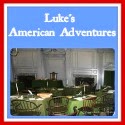 |
| Peyton Randolph public domain via wikimedia commons |
2. The Second Continental Congress came to a conclusion with two decisions. The first was the Declaration of Independence, and the other was a decision to enact a boycott on all imports from England. Although it never got approved, Washington wanted to take the embargo a step further and ban exports to the “mother country.” The Continental Congress decided they would let the colonists trade at their own risk, but they decided to make sure the boycott on imports was enforced by setting up the Continental Association, an agreement by all the colonies to stick to the boycott. The punishment for going against the boycott was the guilty trader would be tarred and feathered.
3. The British, although being the most feared militia in the world, often was careless. For instance, when they fled Fort Ticonderoga, they left behind many cannons. Several times when the British were on the edge of winning a battle, they would stop, rest, and regroup, rather than finishing the battle and winning it, leaving themselves vulnerable for the Patriots to strike. They also did not work from dusk to dawn, unlike the patriots, who used the dark as a cover-up to move their forces into place. Finally, they fought face-to-face, while the patriots improvised guerrilla warfare. Having been a British soldier, George Washington was familiar with his enemy’s fighting style and used his experience as a British soldier to help the Continental Army.
 | |
| General George Washington George Washington at Princeton Charles Willson Peale [Public domain], via Wikimedia Commons |
4. General Washington arrived in Cambridge, Massachusetts on July 2, 1775. When he asked how many men were present in the the Regiment, no one knew the answer. His next question was how much ammunition and gunpowder was there? He was told there were 308 barrels of gunpowder but soon found out there were only 36 when they were actually counted. After finding this major miscalculation, he had difficulty controlling his temper. Seeing how terribly unprepared the soldiers were, and knowing the British were acquiring reinforcements after their losses at Bunker Hill, he was concerned that the Americans would not be a match for the British and they would be defeated easily. He had his soldiers dig strategic trenches and paths to shoot from and ferry ammunition safely in order to maximize the small, inexperienced force he now controlled.
5. George Washington was present in the crowd when the Declaration of
Independence was proclaimed in Boston on July 18, 1776. The crowd
demanded King George III’s coat of arms be taken down, and his statue be
taken away. It was then hauled away and melted down and used for
munitions.
You can read Part I of A Biography of George Washington by clicking here.
Part III of A Biography of George Washington can be found here.

©2012- 2015 Adventures with Jude. All rights reserved. All text, photographs, artwork, and other content may not be reproduced or transmitted in any form without the written consent of the author. http://adventureswithjude.com




No comments:
Post a Comment